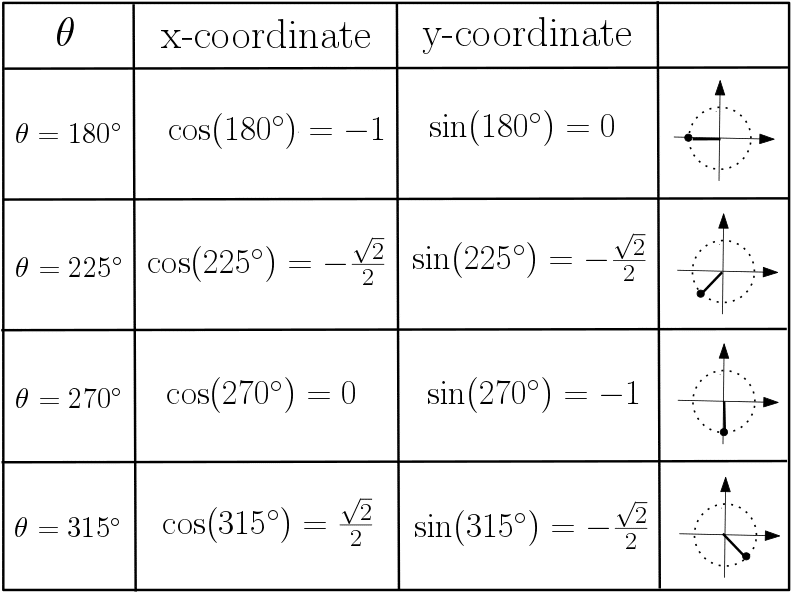Trigonometric Graphs
We derive the trigonometric graphs of sin, cos and tan from the unit circle. Imagine a particle going round the unit circle. Let ![]() measure the anti-clockwise angle between the particle and the
measure the anti-clockwise angle between the particle and the ![]() -axis. We can think of the value of
-axis. We can think of the value of ![]() as the
as the ![]() coordinate of the particle. Similarly, we can think of the value of
coordinate of the particle. Similarly, we can think of the value of ![]() the
the ![]() coordinate. See the table below.
coordinate. See the table below.
Exam questions on trigonometric graphs may expect you to have memorised these values. Additionally, you should also know values of sin and cos at 30 and 60 degrees. See Trigonometric Identities. They may also expect you to perform transformations to trigonometric graphs. See Examples 1 and 2 here after studying the graphs below. Click here for a reminder of Transformations.
The graphs of cos and sin
We now plot the ![]() -coordinate of the particle against the angle. Calculating the coordinates for all
-coordinate of the particle against the angle. Calculating the coordinates for all ![]() using a scientific calculator will give the following curve:
using a scientific calculator will give the following curve:
Local lines of symmetry are vertical lines at every![]() .
.
In other words, they have equation ![]() where
where ![]()
(what does this mean?).
Both ![]() values on the sin and cos graphs are bounded between -1 and 1. The tan graph, however, can take values between
values on the sin and cos graphs are bounded between -1 and 1. The tan graph, however, can take values between ![]() and
and ![]() . Both cos and sin graphs repeat every
. Both cos and sin graphs repeat every ![]() . We say that they have periodicity of
. We say that they have periodicity of ![]() .
.
When solving trigonometric equations, scientific calculators tend to only give default solutions. However, the lines of symmetry above can be used to find all solutions in a given interval. See Trigonometric Equations.
For obvious reasons, sin and cos graphs are sometimes called waves. You may also be interested in the amplitude and wavelength. Firstly, amplitude is the height of the wave. Secondly, the wavelength is how long a single wave is.
The graph of tan
We now plot the ![]() -coordinate of the particle against the angle. Calculating the coordinates for all
-coordinate of the particle against the angle. Calculating the coordinates for all ![]() using a scientific calculator will give the following curve:
using a scientific calculator will give the following curve:
Local lines of symmetry are vertical lines at every![]() .
.
In other words, they have equation ![]() where
where ![]()
(what does this mean?).
Recall that ![]() from the trigonometric identities. The graph of
from the trigonometric identities. The graph of ![]() is given below. It can be thought of as the ratio of vertical to horizontal components of the above particle.
is given below. It can be thought of as the ratio of vertical to horizontal components of the above particle.
As opposed to cos and sin, tan is not restricted to taking values between -1 and 1. Tan can in fact have any positive or negative values. However, the tan graph has asymptotes – lines that are never touched. These lines occur every ![]() starting at
starting at ![]() . They appear as a result of dividing by
. They appear as a result of dividing by ![]() in the expression
in the expression ![]() . Tan has no reflectional lines of symmetry but it does have a periodicity of
. Tan has no reflectional lines of symmetry but it does have a periodicity of![]() .
.



